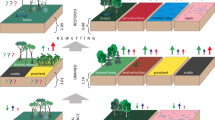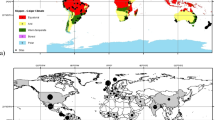Abstract
Peatlands are a highly effective natural carbon sink. However, the future of the carbon stored in these ecosystems is still uncertain because of the pressure they undergo. An estimation of the peatland carbon balance shows whether the system functions as a carbon sink or a carbon source. La Guette peatland is a temperate Sphagnum-dominated peatland invaded by vascular plants. The studied site was hydrologically disturbed for years by a road crossing its southern part and draining water out of the system. Our aim was to estimate the main carbon fluxes and to calculate the carbon balance at the ecosystem scale. To reach this goal, CO2 and CH4 fluxes, DOC content as well as environmental variables were measured monthly for 2 years on 20 plots distributed across the site to take into account spatial variability. The peatland carbon balance was estimated using empirical models. Results showed that the CO2 fluxes were above 1000 gC m−2 yr−1. In 2013 and 2014 the peatland was a net C source to the atmosphere with an emission of 220 ± 33 gC m−2 yr−1. These results provide evidence that restoration should be performed in order to reduce the water losses and favour the Sphagnum-dominance of this peatland.








Similar content being viewed by others
Data Availability
Not applicable.
Code Availability
Not applicable.
References
Akaike H (1974) A new look at the statistical model identification, in: selected papers of Hirotugu Akaike. Springer, Berlin, pp 215–222
Armstrong A, Waldron S, Ostle NJ, Richardson H, Whitaker J (2015) Biotic and abiotic factors interact to regulate northern peatland carbon cycling. Ecosystems 18(8):1395–1409
Baird AJ, Green SM, Brown E, Dooling GP (2019) Modelling time-integrated fluxes of CO2 and CH4 in peatlands: a review. Mires Peat 24:1–15. https://doi.org/10.19189/MaP.2019.DW.395
Ballantyne DM, Hribljan JA, Pypker TG, Chimner RA (2014) Long-term water table manipulations alter peatland gaseous carbon fluxes in northern Michigan. Wetlands Ecology and Management 22:35–47. https://doi.org/10.1007/s11273-013-9320-8
Berendse F, Van Breemen N, Rydin H, Buttler A, Heijmans M, Hoosbeek MR, Lee JA, Mitchell E, Saarinen T, Vasander H (2001) Raised atmospheric CO2 levels and increased N deposition cause shifts in plant species composition and production in Sphagnum bogs. Global Change Biology 7:591–598
Bernard-Jannin L, Binet S, Gogo S, Leroy F, Défarge C, Jozja N, Zocatelli R, Perdereau L, Laggoun-Défarge F (2018) Hydrological control of dissolved organic carbon dynamics in a rehabilitated Sphagnum-dominated peatland: a water-table based modelling approach. Hydrology and Earth System Sciences 22:4907–4920. https://doi.org/10.5194/hess-22-4907-2018
Beyer C, Höper H (2015) Greenhouse gas exchange of rewetted bog peat extraction sites and a Sphagnum cultivation site in Northwest Germany. Biogeosciences 12:2101–2117. https://doi.org/10.5194/bg-12-2101-2015
Beyer C, Liebersbach H, Höper H (2015) Multiyear greenhouse gas flux measurements on a temperate fen soil used for cropland or grassland. Journal of Plant Nutrition and Soil Science 178:99–111. https://doi.org/10.1002/jpln.201300396
Binet S, Gogo S, Laggoun-Défarge F (2013) A water-table dependent reservoir model to investigate the effect of drought and vascular plant invasion on peatland hydrology. Journal of Hydrology 499:132–139. https://doi.org/10.1016/j.jhydrol.2013.06.035
Bortoluzzi E, Epron D, Siegenthaler A, Gilbert D, Buttler A (2006) Carbon balance of a European mountain bog at contrasting stages of regeneration. The New Phytologist 172:708–718
Bubier JL, Moore TR, Bellisario L, Comer NT, Crill PM (1995) Ecological controls on methane emissions from a northern Peatland complex in the zone of discontinuous permafrost, Manitoba, Canada. Global Biogeochemical Cycles 9:455–470. https://doi.org/10.1029/95GB02379
Bubier JL, Moore TR, Bledzki LA (2007) Effects of nutrient addition on vegetation and carbon cycling in an ombrotrophic bog. Global Change Biology 13:1168–1186. https://doi.org/10.1111/j.1365-2486.2007.01346.x
Burnham KP, Anderson DR (eds) (2002) Model selection and multi-model inference. Springer, New York
Buttler A, Robroek BJ, Laggoun-Défarge F, Jassey VE, Pochelon C, Bernard G, Delarue F, Gogo S, Mariotte P, Mitchell EA (2015) Experimental warming interacts with soil moisture to discriminate plant responses in an ombrotrophic peatland. Journal of Vegetation Science 26:964–974
Carroll P, Crill P (1997) Carbon balance of a temperate poor fen. Global Biogeochemical Cycles 11:349–356
Chambers FM, Mauquoy D, Todd PA (1999) Recent rise to dominance of Molinia caerulea in environmentally sensitive areas: new perspectives from palaeoecological data. Journal of Applied Ecology 36(5):719–733
Chapin FS, Woodwell GM, Randerson JT, Rastetter EB, Lovett GM, Baldocchi DD et al (2006) Reconciling carbon-cycle concepts, terminology, and methods. Ecosystems 9(7):1041–1050
Chimner RA, Pypker TG, Hribljan JA, Moore PA, Waddington JM (2017) Multi-decadal changes in water table levels alter peatland carbon cycling. Ecosystems 20(5):1042–1057
Christensen JH, Krishna Kumar K, Aldrian E et al (2013) The physical science basis. Contribution of Working Group I to the Fifth Assessment Report of the Intergovernmental Panel on Climate Change. Cambridge University Press, Cambridge, pp 1217–1308. https://doi.org/10.1017/CBO9781107415324.028
Ciais P, Sabine C, Bala G et al (2013) The physical science basis. Contribution of Working Group I to the Fifth Assessment Report of the Intergovernmental Panel on Climate Change. Cambridge University Press, Cambridge, pp 465–570. https://doi.org/10.1017/CBO9781107415324.015
D'Angelo, B. (2015). Variabilité spatio-temporelle des émissions de GES dans une tourbière à Sphaignes: effets sur le bilan carbone (Doctoral dissertation)
Dieleman CM, Branfireun BA, McLaughlin JW, Lindo Z (2015) Climate change drives a shift in peatland ecosystem plant community: implications for ecosystem function and stability. Global Change Biology 21(1):388–395. https://doi.org/10.1111/gcb.12643
Francez AJ, Vasander H (1995) Peat accumulation and peat decomposition after human disturbance in French and Finnish mires. Acta Oecologica 16(5):599–608
Gogo S, Laggoun-Défarge F, Delarue F, Lottier N (2011) Invasion of a Sphagnum-peatland by Betula spp and Molinia caerulea impacts organic matter biochemistry. Implications for carbon and nutrient cycling. Biogeochemistry 106:53–69. https://doi.org/10.1007/s10533-010-9433-6
Görres CM, Kutzbach L, Elsgaard L (2014) Comparative modeling of annual CO2 flux of temperate peat soils under permanent grassland management. Agriculture, Ecosystems and Environment 186:64–76. https://doi.org/10.1016/j.agee.2014.01.014
Guimbaud C, Catoire V, Gogo S, Robert C, Chartier M, Laggoun-Défarge F, Grossel A, Albéric P, Pomathiod L, Nicoullaud B, Richard G (2011) A portable infrared laser spectrometer for flux measurements of trace gases at the geosphere–atmosphere interface. Measurement Science and Technology 22:075601. https://doi.org/10.1088/0957-0233/22/7/075601
Guimbaud C, Noel C, Chartier M, Catoire V, Blessing M, Gourry JC, Robert C (2016) A quantum cascade laser infrared spectrometer for CO2 stable isotope analysis: field implementation at a hydrocarbon contaminated site under bio-remediation. Journal of Environmental Sciences 40:60–74. https://doi.org/10.1016/j.jes.2015.11.015
Jacobs CMJ, Jacobs AFG, Bosveld FC, Hendriks DMD, Hensen A, Kroon PS, Moors EJ, Nol L, Schrier-Uijl A, Veenendaal EM (2007) Variability of annual CO2 exchange from Dutch grasslands. Biogeosciences 4:803–816. https://doi.org/10.5194/bg-4-803-2007
Jacotot A, Gogo S, Perdereau L, Paroissien JB, Guimbaud C, Laggoun-Défarge F (in prep) High frequency measurements of CO2 and CH4 fluxes in a temperate peatland dominated by Molinia caerulea (La Guette, France)
Joosten H, Clarke D (2002) Wise use of mires and Peatlands. International Mire Conservation Group and International Peat Society, Jyväsk
June T, Evans JR, Farquhar GD (2004) A simple new equation for the reversible temperature dependence of photosynthetic electron transport: a study on soybean leaf. Functional Plant Biology 31:275–283
Kandel TP, Elsgaard L, Lærke PE (2013) Measurement and modelling of CO2 flux from a drained fen peatland cultivated with reed canary grass and spring barley. GCB Bioenergy 5:548–561. https://doi.org/10.1111/gcbb.12020
Koehler AK, Sottocornola M, Kiely G (2011) How strong is the current carbon sequestration of an Atlantic blanket bog? Global Change Biology 17:309–319. https://doi.org/10.1111/j.1365-2486.2010.02180.x
Lappalainen E (1996) Global peat resources. International Peat Society, Jyskä
Leroy F, Gogo S, Guimbaud C, Bernard-Jannin L, Yin X, Belot G, Shuguang W, Laggoun-Défarge F (2019) CO2 and CH4 budgets and global warming potential modifications in Sphagnum-dominated peat mesocosms invaded by Molinia caerulea. Biogeosciences 16:4085–4095
Luan J, Liu S, Wu J, Wang M, Yu Z (2018) The transient shift of driving environmental factors of carbon dioxide and methane fluxes in Tibetan peatlands before and after hydrological restoration. Agricultural and Forest Meteorology 250:138–146
Lund M, Christensen TR, Lindroth A, Schubert P (2012) Effects of drought conditions on the carbon dioxide dynamics in a temperate peatland. Environmental Research Letters 7:045704. https://doi.org/10.1088/1748-9326/7/4/045704
Luo Y, Zhou X (2006). Chapter 5 - controlling factors. In Luo, Y., Zhou, X., éditeurs : Soil Respiration and the Environment, pages 79–105. Academic Press, Burlington
Myhre G, Shindell D, Bréon FM, Collins W, Fuglestvedt J, Huang J, Koch D, Lamarque JF, Lee D et al (2013) Anthropogenic and Natural Radiative Forcing, In: Climate Change 2013: The Physical Science Basis, Contribution of Working Group 1 to the Fifth Assessment Report of the Intergovernmental Panel on Climate Change, Table, 8, 714
Noyce GL, Varner RK, Bubier JL, Frolking S (2014) Effect of Carex rostrata on seasonal and interannual variability in peatland methane emissions. Journal of Geophysical Research – Biogeosciences 119(1):24–34
Peichl M, Öquist M, Löfvenius MO, Ilstedt U, Sagerfors J, Grelle A, Lindroth A, Nilsson MB (2014) A 12-year record reveals pre-growing season temperature and water table level threshold effects on the net carbon dioxide exchange in a boreal fen. Environmental Research Letters 9:055006. https://doi.org/10.1088/1748-9326/9/5/055006
Pelletier L, Moore TR, Roulet NT, Garneau M, Beaulieu-Audy V (2007) Methane fluxes from three peatlands in the La Grande Rivière watershed, James Bay lowland, Canada. Journal of Geophysical Research 112:G01018. https://doi.org/10.1029/2006JG000216
Pumpanen J, Kolari P, Ilvesniemi H, Minkkinen K, Vesala T, Niinistö S, Lohila A, Larmola T, Morero M, Pihlatie M, Janssens I, Yuste JC, Grünzweig JM, Reth S, Subke JA, Savage K, Kutsch W, Østreng G, Ziegler W, Anthoni P, Lindroth A, Hari P (2004) Comparison of different chamber techniques for measuring soil CO2 efflux. Agricultural and Forest Meteorology 123:159–176. https://doi.org/10.1016/j.agrformet.2003.12.001
Robert C (2007) Simple, stable, and compact multiple-reflection optical cell for very long optical paths. Applied Optics 46:5408–5418
Rydin H, Jeglum JK (2013) The biology of peatlands, 2nd edn. Oxford university press, Oxford
Strack M (ed) (2008) Peatlands and climate change. IPS, International Peat Society
Strack M, Zuback YCA (2013) Annual carbon balance of a peatland 10 yr following restoration. Biogeosciences 10:2885–2896. https://doi.org/10.5194/bg-10-2885-2013
Trudeau NC, Garneau M, Pelletier L (2014) Interannual variability in the CO2 balance of a boreal patterned fen, James Bay, Canada. Biogeochemistry 118:371–387
Vanselow-Algan M, Schmidt SR, Greven M, Fiencke C, Kutzbach L, Pfeiffer EM (2015) High methane emissions dominated annual greenhouse gas balances 30 years after bog rewetting. Biogeosciences 12:4361–4371. https://doi.org/10.5194/bg-12-4361-2015
Waddington JM, Roulet NT (2000) Carbon balance of a boreal patterned peatland. Global Change Biology 6:87–97. https://doi.org/10.1046/j.1365-2486.2000.00283.x
Ward SE, Ostle NJ, Oakley S, Quirk H, Henrys PA, Bardgett RD (2013) Warming effects on greenhouse gas fluxes in peatlands are modulated by vegetation composition. Ecology Letters 16(10):1285–1293
Worrall F, Burt TP, Rowson JG, Warburton J, Adamson JK (2009) The multi-annual carbon budget of a peat-covered catchment. Science of the Total Environment 407:4084–4094
Yu Z, Loisel J, Brosseau DP, Beilman DW, Hunt SJ (2010) Global peatland dynamics since the last glacial maximum. Geophysical Research Letters 37. https://doi.org/10.1029/2010GL043584
Acknowledgements
The authors gratefully acknowledge P. Jacquet and C. Robert for their assistance in SPIRIT maintenance. We also thank E. Rowley-Jolivet for revision of the English version.
Funding
This work was supported by the Labex VOLTAIRE (ANR-10-LABX-100-01) and CARBIODIV project (2012–00073566).
Author information
Authors and Affiliations
Contributions
BD, SG and FLD designed the experiment.
BD, SG, CG, FL and FLM collected data.
BD, SG, CG, FL and FLM performed model simulations and data analysis.
BD and FL prepared the manuscript with contributions from all co-authors.
AJ and RZ reviewed and corrected the manuscript.
Corresponding author
Ethics declarations
Ethics Approval
Not applicable.
Consent to Participate
Not applicable.
Consent for Publication
Not applicable.
Conflict of Interest
The authors declare that they have no known competing financial interests or personal relationships that could have appeared to influence the work reported in this paper.
Additional information
Publisher’s Note
Springer Nature remains neutral with regard to jurisdictional claims in published maps and institutional affiliations.
Rights and permissions
About this article
Cite this article
D’Angelo, B., Leroy, F., Guimbaud, C. et al. Carbon Balance and Spatial Variability of CO2 and CH4 Fluxes in a Sphagnum-Dominated Peatland in a Temperate Climate. Wetlands 41, 5 (2021). https://doi.org/10.1007/s13157-021-01411-y
Received:
Accepted:
Published:
DOI: https://doi.org/10.1007/s13157-021-01411-y




